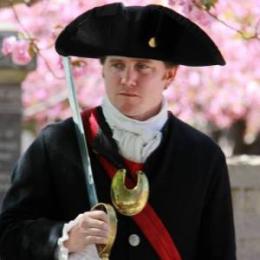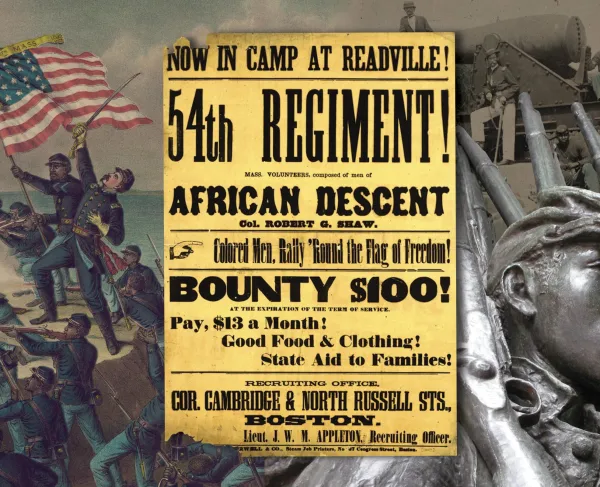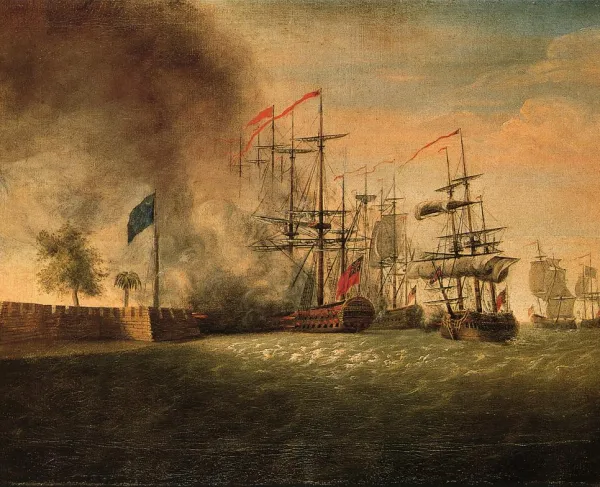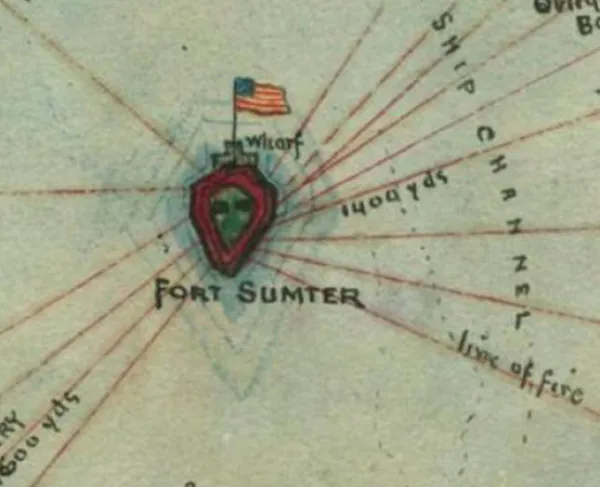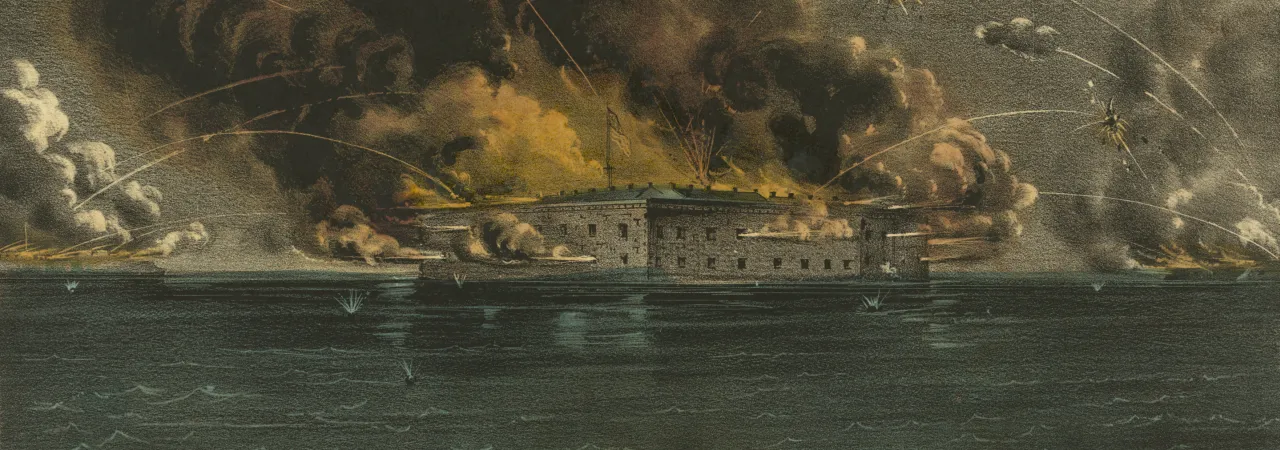
Bombardment of Fort Sumter, Charleston Harbor: 12th & 13th of April, 1861.
Charleston, South Carolina, was one of the most important cities during the American Civil War. Both symbolically and strategically, the city became the epicenter of some of the most dramatic moments of the war. Charleston was the scene of secession's beginning, often referred to as the "Cradle of the Confederacy."
Charleston, South Carolina, was one of the largest cities in the South in 1860. It was a center of Democratic politics and hosted a convention for the 1860 presidential ticket in the spring of 1860. With the Democratic ticket split between Stephen A. Douglas and John C. Breckenridge, Republican candidate Abraham Lincoln won the presidency in November of 1860. A vocal opponent of the expansion of slavery in the western territories, South Carolina politicians began arguing for secession. Southern fire-eaters such as Robert Barnwell Rhett and Edmund Ruffin pushed for immediate secession. South Carolina set up a special secession convention to decide the issue in December 1860. Originally convening in Columbia, South Carolina, due to a smallpox outbreak, the tradition ultimately moved to Charleston, well known for its support for secession.
Fearful of the new Republican administration, the South Carolina convention voted unanimously 169-0 in favor of seceding from the Union. The Secession Ordinance was passed in December 1860, with Charleston newspapers declaring "The Union is Dissolved" the following day. Celebrations broke out in Charleston. Edmund Ruffin noted that "military companies paraded, salutes were fired . . . bonfires . . . were lighted in the principal streets, rockets discharged, and innumerable crackers fired." As South Carolinians celebrated, a delegation from South Carolina went to Washington, DC, to negotiate the transfer of federal property in the newly independent republic.
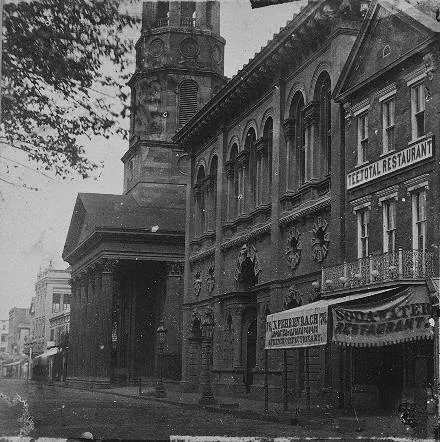
In Charleston harbor was stationed a company of United States soldiers under the command of Major Robert Anderson at Fort Moultrie. With less than a hundred men, Anderson began to feel that he was in an isolated spot at Fort Moultrie. On December 26, 1860, he made the decision to spike the artillery at Moultrie, burn the carriages, and move his company into the middle of the harbor and occupy the still incomplete Fort Sumter. South Carolina militia forces quickly captured the remaining fortifications in the harbor and began to train artillery on the federal soldiers at Fort Sumter. On January 9, 1861, President James Buchanan attempted to resupply the men at Fort Sumter and sent the steamer Star of the West to get to the fort. However, cadets from the Citadel military college opened fire on the ship. The Star of the West fell back without returning fire. This would be the last attempt by the Buchanan administration to resupply the fort.
Over the next few months, six other Deep South states (Mississippi, Alabama, Florida, Louisiana, Georgia, and Texas) seceded and joined together to form the Confederate States of America. The newly inaugurated President Jefferson Davis placed Confederate General P.G.T. Beauregard in charge of the military situation in Charleston Harbor. Confederate fortifications were built up in the event violence was to break out in the harbor.
On March 4, 1861, Abraham Lincoln was inaugurated as the sixteenth President of the United States. Lincoln's administration did not recognize the secession of the Deep South States nor the Confederate States as a legitimate government. Lincoln did not want to evacuate Anderson's men if it was viewed as a recognition of the Confederacy's sovereignty. Likewise, the Confederacy could not allow the United States troops to be resupplied or reinforced should their sovereignty be questioned.
Lincoln decided to resupply Anderson's men and dispatched a fleet to Charleston harbor, realizing the mission could precipitate civil war. On learning of the expedition, Jefferson Davis ordered the fort to be evacuated, and if Anderson refused, to "reduce" the fort. Anderson was given the ultimatum in the early morning of April 12, 1861. Anderson said he would not evacuate until his supplies ran out in a few days. Unsatisfied with the response, the Confederates warned Anderson a bombardment would commence.
At 4:30 a.m., at Fort Johnson on James Island, Confederate Captain George S. James ordered Lieutenant Henry S. Farley to fire on Fort Sumter. Lt. Farley pulled the lanyard of a 10-inch mortar. The mortar shell arced across the harbor and exploded over Fort Sumter. This signal shot let all the other batteries in the harbor open fire on Sumter. This was the first shot of the American Civil War. Edmund Ruffin of Virginia was the man most often associated with the first shot. The 67-year-old secessionist was posted on nearby Morris Island with the Palmetto Guard. He fired the first shot after this signal and was the first shot to hit the brick fort.
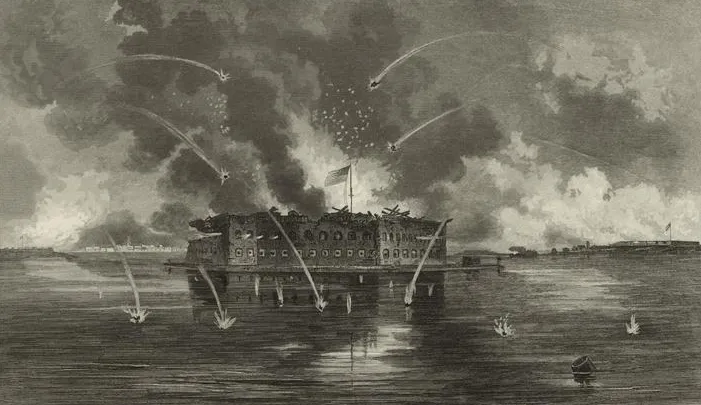
A bombardment commenced with Confederate artillery firing on Fort Sumter from Morris Island, Sullivan's Island, Mount Pleasant, and James Island. Inside the fort, Anderson's men returned fire. The battle lasted for 34 hours. The Confederates began firing hot shots into the fort. These cannonballs were heated to be red hot, so when fired, they would catch wooden buildings on fire. Hotshot caused the officers' quarters to catch fire, and black smoke billowed out of the fort. Recognizing the futility of continuing the fight, on April 13, 1861, Anderson agrees to surrender the fort. Amazingly not one person was killed in the opening battle of the bloodiest war in American history.
Anderson and his men were not taken prisoner and were allowed to return their flags and belongings north with them. They were also allowed to do a ceremony with a cannon salute as they left. During the ceremony, the cannon accidentally exploded, resulting in some of the first deaths of the American Civil War. Confederate soldiers immediately took possession of the fort. In the Deep South, the Confederate victory was hailed as an essential declaration of their independence from the Union. In the North, the firing on Fort Sumter was viewed as an assault on the American Union and rallied thousands to the defense of the American flag. In immediate response to the firing on Fort Sumter, Lincoln called for 75,000 volunteers to form an army to crush the Confederacy. With the raising of troops and the unwillingness to invade other Southern states, the Upper South (Virginia, North Carolina, Tennessee, and Arkansas) reluctantly seceded from the Union and joined the Confederacy as well.
As the scene of the South's initial secession and the site of the first shots of the war, Charleston and Fort Sumter immediately became a target for the Union war efforts.
The Union Navy began a harbor blockade in May of 1861 that would last throughout the war. Confederate smugglers and blockade runners would attempt to get through the blockade with mixed success. In November 1861, the Union took Port Royal near Beaufort, South Carolina. They began to move up towards Charleston. On December 11, 1816, a significant fire cut through Charleston that burned more than 600 structures in the city before being put out.
On June 16, 1862, a Union army attempted to get through the Confederate defenses on James Island at a location known as Secessionville. The ensuing battle resulted in a significant Confederate victory over the Union's attempt at a frontal assault.
In April 1863, the Union returned to Charleston harbor to attempt to take the city. On April 7, 1863, the Union used ironclad ships to assault Fort Sumter. The ships were beaten back. In the summer of 1863, the Union forces focused on taking Morris Island near the entrance to the harbor. After getting a foothold on the island, they began a siege of Charleston that lasted 587 days. To capture Morris Island, the Union led two failed assaults on the Confederate Fort Wagner on the island. The second of those assaults included the famed 54th Massachusetts Regiment, one of the first African American regiments to see battle in the war. They impressed participants with their bravery and courage under fire.
Rather than more frontal assaults, the Union troops laid siege to the Confederates at Wagner, bombarding their position daily. By September 1863, the Confederates decided to abandon Fort Wagner and Morris Island. Now with control of Morris Island, the Union continued to besiege Charleston. Fort Sumter was now in close range of Union artillery. The rifled artillery pummeled Fort Sumter into ruins. As the brick walls fell, the fort became a heap of rubble that was even more difficult to bombard. The Confederates stubbornly refused to give up the fort and repulsed attempts by the Union to capture the island fort. Throughout the siege, over seven million pounds of metal were fired at the fort by the Union.
While the Union attempted to pound the city into submission, the Confederates tried to use a submarine to sink Union ships that were blockading the city. On February 17, 1864, a small Confederate submarine, the CSS HL Hunley, sailed out of the harbor and torpedoed the Union ship USS Housatonic. The Hunley attempted to return after sinking the Union ship but sank, killing all on board.
In addition to bombarding the Confederate forts, Union artillery aimed its artillery at the civilians in Charleston. Among the cannons firing on Charleston was a massive 8-inch Parrott rifle called the "Swamp Angel." The firing on the city prompted the Confederate commander to move Union prisoners into the city to try and dissuade more shelling of the town. In retaliation, the Union moved Confederate prisoners into a stockade in front of the Union forts on Morris Island. At one point, the Confederate prisoners on Morris Island were at 600. They became known later as the "Immortal 600." The war had devolved in Charleston harbor from the initial battle, where officers recognized and honored their opponents, to total war, where both sides used prisoners as human shields.
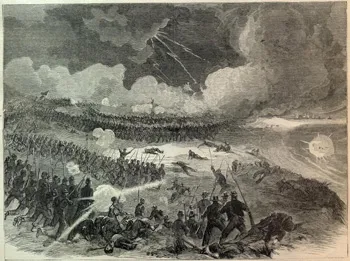
As the military situation for the Confederates devolved in other theaters of the war, the Confederates still had Charleston. However, after General William T. Sherman successfully marched his army from Atlanta to Savannah, he looked to move his army into South Carolina, where he had little compassion for the first state to secede from the Union. Sherman noted, "The whole army is burning with insatiable desire to wreck vengeance upon South Carolina. I almost tremble at her fate." Union General Henry Halleck told Sherman he hoped that if Charleston were captured "by some accident the place may be destroyed, and if a little salt should be sown upon its site it may prevent the growth of future crops of nullification and secession."
Sherman, however, was not headed to Charleston. Instead, he went to the more militarily significant Columbia, South Carolina location, which he destroyed. With Union troops to their North and west in Columbia, the Confederates were in an untenable situation in Charleston and decided to evacuate the city and move north. On February 17, 1865, the Confederates evacuated, and Union troops took Fort Sumter and marched into Charleston.
On April 14, 1865, four years after Major Robert Anderson had lowered the American flag and left Fort Sumter, now General Robert Anderson returned for a ceremonial re-raising of the American flag on the battered remnants of Fort Sumter. That same day, President Abraham Lincoln was shot at Ford's Theatre in Washington, DC.
Charleston, South Carolina, had witnessed some of the most important events of the American Civil War. It continues to be remembered for its close associations with the Confederacy and the Civil War.
Related Battles
685
204
1,515
174
